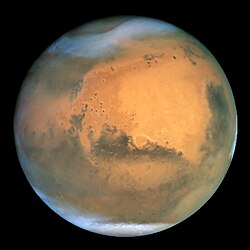Seznam plání na Marsu
Toto je seznam planin na Marsu. Planiny mohou být pojmenovány „planitia“ nebo „planum“, v závislosti na jejich výšce.
Planitia
Planitia (množné číslo: planitiae) je latinský název pro planinu.
Plana
Planum (množné číslo: plana) je latinské slovo pro rovinu.
Reference
V tomto článku byl použit překlad textu z článku List of plains on Mars na anglické Wikipedii.
Externí odkazy
 Obrázky, zvuky či videa k tématu Seznam plání na Marsu na Wikimedia Commons
Obrázky, zvuky či videa k tématu Seznam plání na Marsu na Wikimedia Commons - Gazetteer of Planetary Nomenclature
Média použitá na této stránce
NASA's Hubble Space Telescope took the picture of Mars on June 26, 2001, when Mars was approximately 68 million kilometers (43 million miles) from Earth — the closest Mars has ever been to Earth since 1988. Hubble can see details as small as 16 kilometers (10 miles) across. The colors have been carefully balanced to give a realistic view of Mars' hues as they might appear through a telescope. Especially striking is the large amount of seasonal dust storm activity seen in this image. One large storm system is churning high above the northern polar cap (top of image), and a smaller dust storm cloud can be seen nearby. Another large dust storm is spilling out of the giant Hellas impact basin in the Southern Hemisphere (lower right).
